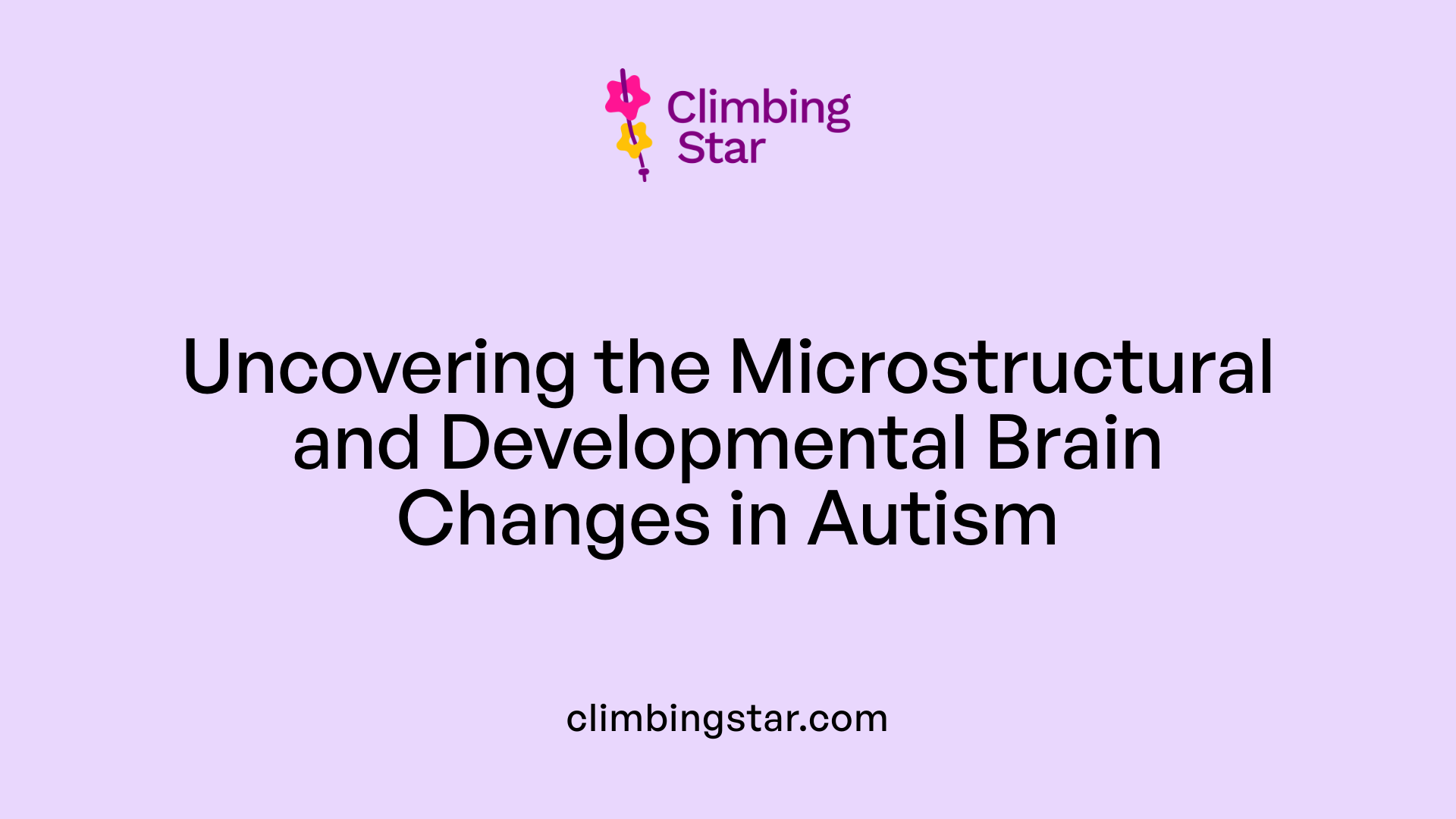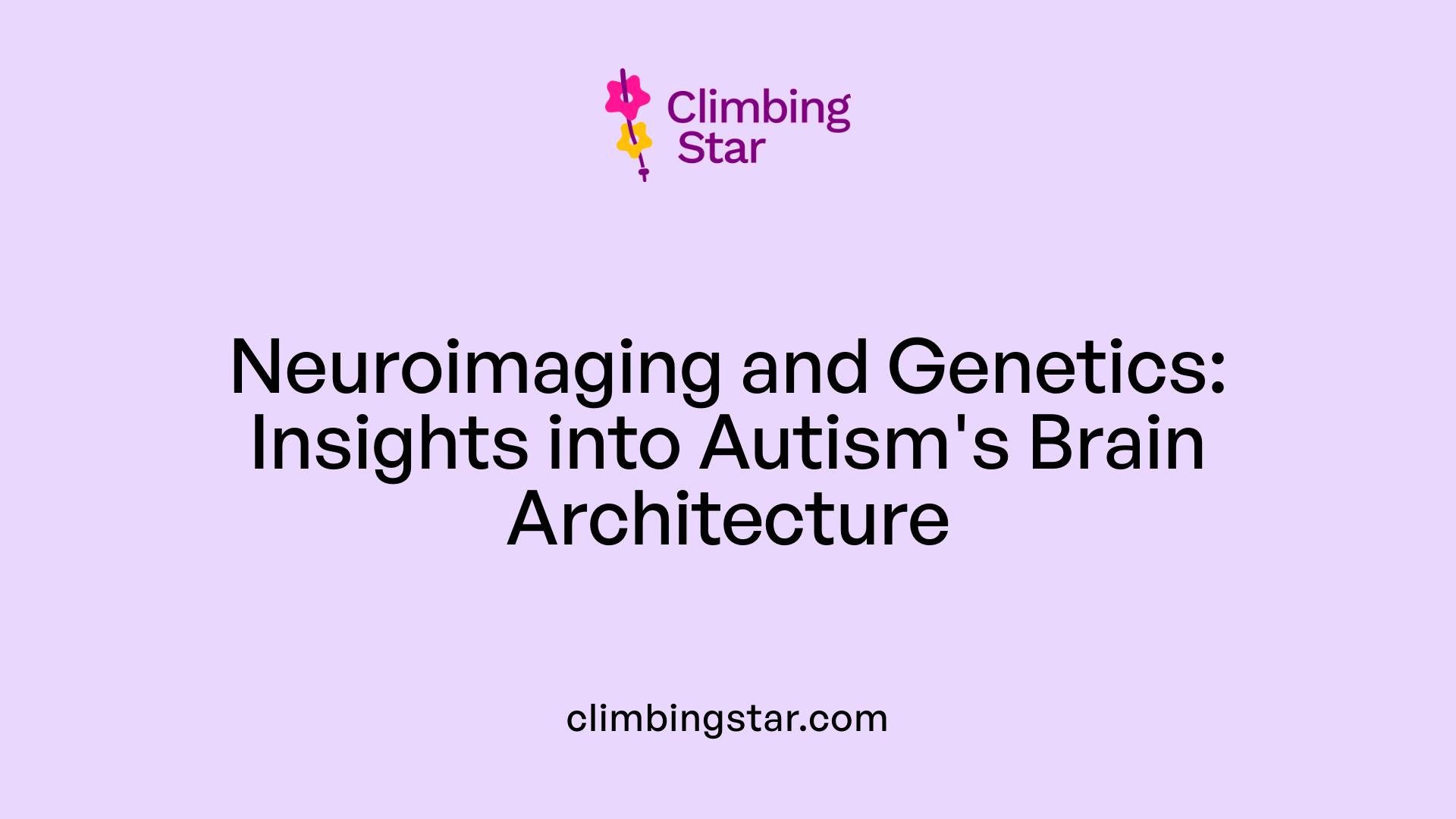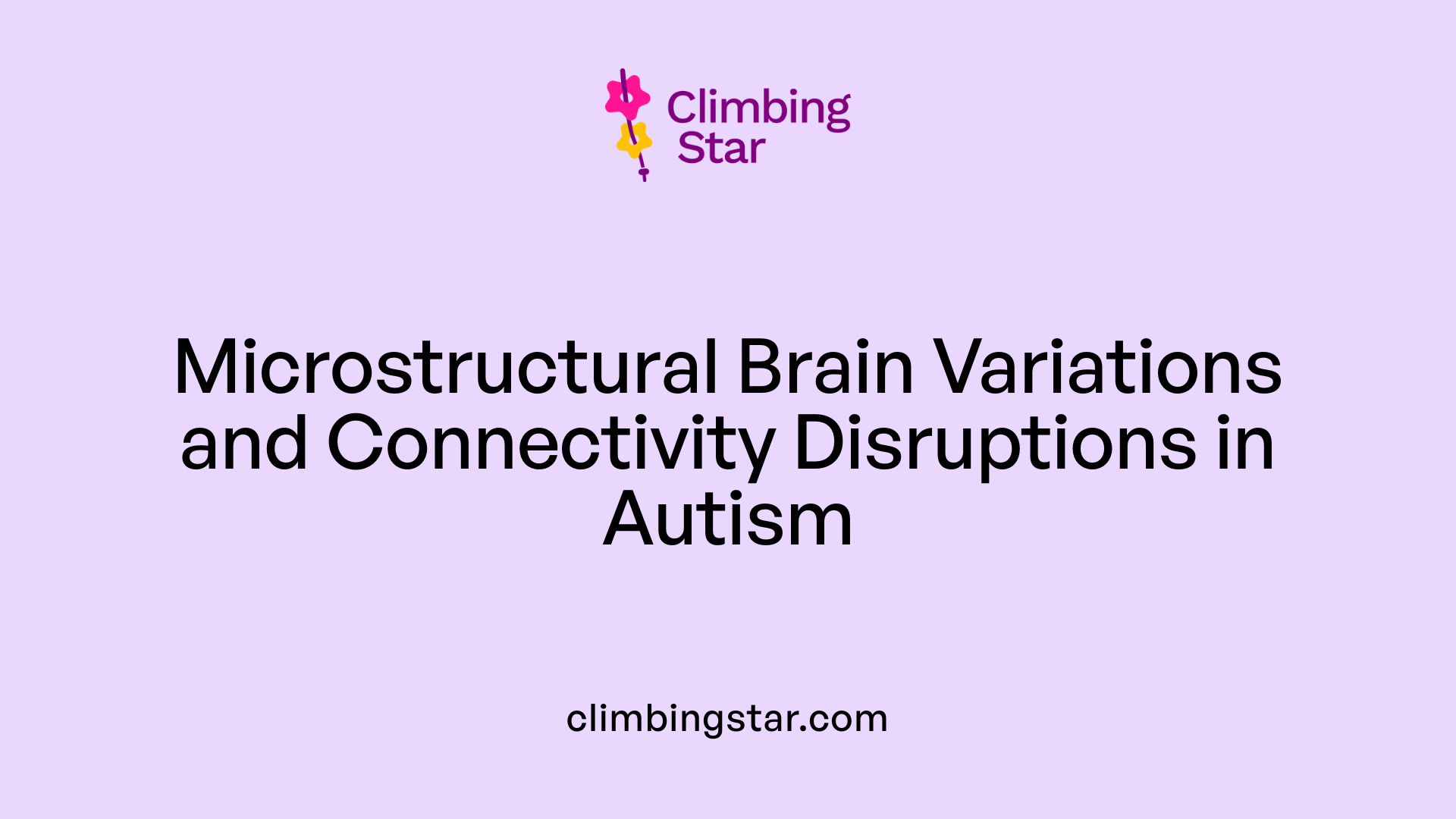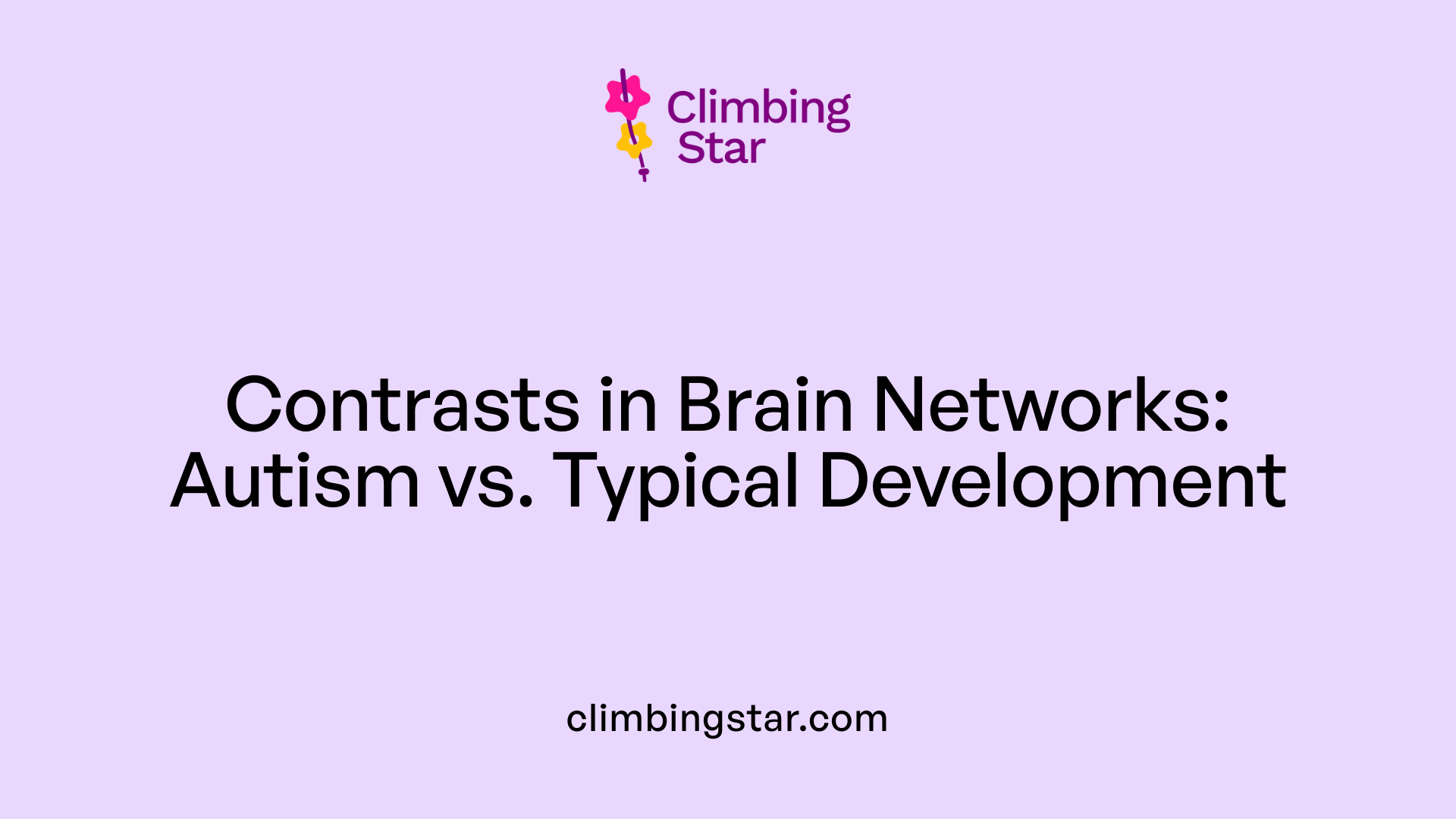Understanding the Distinctive Neurobiology of Autism Spectrum Disorder
Research over the past decades has revealed profound differences between the brains of autistic and neurotypical individuals. These differences encompass structural variations, neural circuitry alterations, synaptic densities, and molecular profiles. By integrating neuroimaging, genetic, and neurobiological data, scientists are advancing towards a comprehensive understanding of the autistic brain, which may pave the way for targeted interventions and improved support strategies.
Structural Brain Differences in Autism

What have studies uncovered about brain microstructure and development in individuals with autism?
Research into the microstructure of the autistic brain reveals significant differences compared to neurotypical individuals. Studies utilizing advanced neuroimaging techniques such as diffusion MRI, TBSS, and GBSS have documented widespread abnormalities in both gray and white matter tissues.
In particular, white matter tracts—like the superior longitudinal fasciculus (SLF), inferior longitudinal fasciculus (ILF), and superior thalamic radiation (STR)—show reduced fractional anisotropy (FA). This reduction indicates disrupted connectivity, which has been linked to autism severity and developmental challenges. Moreover, alterations in brainstem white matter suggest that sensory processing features, common in autism, may originate from brainstem contributions.
These microstructural differences are dynamic, often becoming more pronounced during adolescence and adulthood. Disruptions are notably seen in the corpus callosum and across the entire connectome, highlighting the widespread nature of these changes.
In gray matter, abnormalities such as altered cortical architecture and variations in neuronal density further contribute to atypical brain function. Overall, these findings support the idea that atypical microstructural development plays a central role in shaping autism's behavioral and sensory features.
How do neuroimaging studies reveal structural and functional distinctions in the autistic brain?
Neuroimaging techniques like MRI, fMRI, DTI, and PET scans have uncovered numerous distinctions in the autistic brain. These studies highlight differences in brain volume, connectivity, and tissue composition.
For example, imaging has shown increased or decreased volumes in regions such as the amygdala, cerebellum, and basal ganglia. Early brain overgrowth during childhood is a common finding, followed by normalization or even volume reduction later in life.
Functionally, autism involves altered connectivity patterns. There is often decreased long-range cortical connectivity, which impairs integration of information across the brain, alongside overconnectivity in local circuits. These connectivity patterns influence social, sensory, and cognitive functioning.
At a molecular level, reduced synaptic density across the brain and changes in metabolites indicate neuronal, axonal, and glial abnormalities. Collectively, these neuroimaging findings present a model of atypical brain development that directly relates to the core traits and behavioral manifestations of autism.
What are the neurobiological differences between autistic and neurotypical brains?
Neurological research shows that autistic brains differ from neurotypical ones in several ways. Early in development, many autistic children experience an overgrowth of the frontal cortex, which may lead to subsequent atypical connectivity.
A notable difference is a 17% reduction in synaptic density across the entire brain, measured using PET scans. This decrease correlates with impairments in social communication and repetitive behaviors.
Regionally, structures such as the amygdala are enlarged early on but tend to have fewer neurons in adults with autism. The cortical organization also shows abnormalities, including increased width of minicolumns and disorganized neuronal placement.
On a molecular level, gene expression studies reveal upregulated immune and inflammation-related genes and downregulated genes essential for brain connectivity. Mutations and epigenetic alterations further influence neural circuits.
These neurobiological differences underpin many of the behavioral and cognitive features characteristic of autism.
How does brain development and plasticity vary among different autism subtypes?
Autism encompasses various subtypes with distinct neurodevelopmental trajectories. Some subgroups, like social communication challenges, show typical early brain growth followed by specific connectivity disruptions.
Other subgroups display widespread neuroanatomical differences, including delays and variations in regional growth, cortical thickness, and white matter integrity. These neuroanatomical patterns are closely aligned with their behavioral profiles.
The degree of brain plasticity—the brain's ability to reorganize—also differs among subtypes. For example, some individuals demonstrate significant neural adaptability, while others show more rigid connectivity patterns.
Understanding these differences underscores the importance of personalized approaches in diagnosis and intervention, considering the diverse developmental paths within autism.
Are there genetic and molecular factors that influence brain structure and function in autism?
Genetics play a pivotal role in shaping the neurobiological landscape of autism. Over 800 genes related to synapse function, neural development, immune response, and chromatin modification have been linked to ASD.
Genetic mutations, copy number variations, and epigenetic modifications influence brain morphology and connectivity. For instance, mutations in MECP2, CNTNAP2, neuroligins, and neurexins affect synaptic development and neural circuit formation.
At the molecular level, dysregulated gene expression affects proteins crucial for neuronal communication and development, leading to structural abnormalities. Recent genomic studies reveal that these genetic factors often converge on common pathways impacting brain development.
Thus, both genetic and molecular factors significantly influence the structural and functional neuroanatomy observed in autism.
How do specific brain regions and networks involved in autism differ from those in typical development?
Autistic individuals show marked differences in key brain regions and networks. The social brain network—including the fusiform face area, amygdala, and superior temporal sulcus—often exhibits reduced activation or altered connectivity, impairing social perception.
The default mode network (DMN), essential for self-referential thought and social cognition, tends to be larger or more diffuse in ASD, while the salience network shows reductions, affecting attention and social engagement.
White matter tracts connecting these regions are also atypical, with disruptions in their integrity impacting communication between critical hubs. These neural differences correlate strongly with behavioral traits such as social difficulty and language impairments.
Gene influences on development further modify these networks, leading to the heterogeneity observed across individuals with autism.
What are the current scientific insights into physiological and functional brain activity in autism?
Recent research shows that autism involves widespread alterations in brain activity patterns. Early childhood brain overgrowth is followed by atypical development of white matter pathways.
Functional imaging reveals underconnectivity between frontal and posterior regions, with abnormal activity in face and emotion recognition areas, like the fusiform face area and amygdala.
Developmental studies highlight early lateralization differences, with atypical right hemisphere language dominance, and altered activity in the posterior superior temporal gyrus related to social perception.
Molecular imaging, including PET scans, has identified reductions in synaptic density, which correlates with social and communication difficulties.
Overall, these insights portray autism as a disorder of disrupted neural circuits—both in structure and function—that evolve over development, affecting core social, sensory, and cognitive abilities.
Neuroimaging and Genetic Insights into Autism

How do specific brain regions and networks involved in autism differ from those in typical development?
Autistic brains show notable differences in both structure and function compared to neurotypical individuals. Key regions involved in social cognition, such as the amygdala, superior temporal gyrus, and fusiform face area, often display reduced activation or atypical connectivity in individuals with ASD. These areas are crucial for recognizing faces, interpreting social cues, and emotional processing.
The default mode network (DMN), which is active during rest and involved in self-referential thinking, tends to be larger, while the salience network, essential for detecting relevant stimuli and switching between networks, is smaller in young children with autism. These alterations emerge early, around age 2, impacting attention, social engagement, and language.
White matter tracts connecting these regions also show abnormalities, with decreased integrity and atypical cortical thickness observed in multiple cortical and subcortical regions. Disrupted communication between the prefrontal cortex, temporal lobes, and limbic areas contributes to challenges in social behaviors, language, and cognition.
Genetic influences play a significant role in shaping these neural differences. Variations in genes affect brain development processes—such as neuronal growth, migration, and connection formation—leading to differences in the size, shape, and connectivity of key brain regions that manage social behavior, language, and cognitive functions.
What are the current scientific insights into physiological and functional brain activity in autism?
Recent advances in neuroimaging have deepened our understanding of brain activity patterns in ASD. Studies consistently show widespread atypicalities in neural connectivity, notably reduced long-range communication between the frontal and posterior regions of the brain, which impacts complex cognitive functions and social reasoning.
During early childhood, some parts of the brain, including the amygdala and prefrontal cortex, show overgrowth, which then stabilizes or decreases with age. White matter pathways, which facilitate rapid information transfer, are often underdeveloped or disrupted, further complicating neural efficiency.
Functional MRI investigations reveal abnormalities in networks responsible for social skills, language, and emotional processing. For example, the face recognition areas—like the fusiform gyrus—exhibit atypical activation, correlating with difficulties in social engagement.
Recent molecular imaging, especially PET scans measuring synaptic density with novel radiotracers like 11C-UCB-J, have provided valuable insight into the biological underpinnings of these functional changes. These scans reveal a 17% reduction in synapse numbers across autistic adult brains, which correlates with social impairments such as reduced eye contact and repetitive behaviors.
In sum, the disrupted connectivity and altered activity patterns across various brain networks are at the core of the diverse symptoms seen in ASD. Advances in imaging techniques are helping us link these functional abnormalities to underlying molecular and structural changes, paving the way for targeted interventions.
Microstructural Changes and Brain Connectivity in Autism

What have studies uncovered about brain microstructure and development in individuals with autism?
Research has shown that individuals with autism spectrum disorder (ASD) present notable microstructural abnormalities in both grey and white matter regions of the brain. These differences include variations in neuronal density, synaptic connections, and the overall architecture of the cortex. For instance, white matter tracts such as the superior longitudinal fasciculus (SLF), inferior longitudinal fasciculus (ILF), and superior thalamic radiation (STR) tend to have reduced fractional anisotropy (FA) values, indicating disruptions in neural connectivity.
These microstructural changes are associated with autism severity and developmental outcomes. Sensory processing features, commonly seen in autism, appear to be linked to alterations in brainstem white matter. Importantly, these structural anomalies are not static; they evolve through different life stages. Adolescents and adults often display more pronounced connectivity disruptions, especially in the corpus callosum and across widespread network regions.
Overall, studies highlight that these atypical microstructural features and their developmental trajectories are central to understanding the biological basis of autism. They influence core characteristics such as social deficits and sensory processing difficulties, emphasizing the importance of lifespan-focused research in this field.
How do neuroimaging studies reveal structural and functional distinctions in the autistic brain?
Neuroimaging tools such as MRI, fMRI, diffusion tensor imaging (DTI), magnetic resonance spectroscopy (MRS), positron emission tomography (PET), and magnetoencephalography (MEG) have been instrumental in uncovering differences in the autistic brain. These studies identify variations in brain volume, tissue composition, and connectivity patterns.
Specific regions, including the amygdala, cerebellum, and basal ganglia, often show abnormal size or growth trajectories. For example, early overgrowth of the brain in infancy transitions to atypical development later, contributing to behavioral difficulties. Connectivity analyses reveal decreased long-distance cortico-cortical links coupled with increased local connectivity, impairing integrated social, sensory, and cognitive functions.
Metabolic changes observed in neurochemical studies also suggest abnormalities in synaptic function, neuronal health, and glial cell activity. These structural and functional differences support a comprehensive model where ASD involves atypical neural development, disrupted circuitry, and biochemical alterations—the foundation of many behavioral symptoms.
What are the neurobiological differences between autistic and neurotypical brains?
Autistic brains consistently display neurobiological variations compared to neurotypical individuals. Early in development, these include increased brain volume, particularly noticeable in the first years of life, which later normalizes or decreases in some regions.
A prominent finding from PET scans is a 17% reduction in synaptic density across the brain, correlating with impairments in social communication and behavior. Region-specific changes, such as in the amygdala, include early enlargement in children and reduction of neurons in adults, affecting emotional and social processing.
At the molecular level, gene expression profiling reveals an upregulation of genes involved in immune responses and inflammation and a downregulation of those involved in connectivity and inhibitory signaling. Alterations in neuronal organization, such as wider minicolumns and cortical disorganization, are also common.
Mutations in genes related to synapse formation and function, along with epigenetic modifications, underpin many neurobiological differences. Collectively, these findings underscore that autism involves complex, multi-level alterations in brain structure, chemistry, and gene expression.
How does brain development and plasticity vary among different autism subtypes?
Brain development in autism is highly heterogeneous, reflecting diverse genetic and environmental influences that define various subtypes. Some subtypes, characterized by prominent social deficits, show typical early brain growth but later exhibit disrupted connectivity patterns, especially between frontal and temporal regions.
Other subgroups display extensive neuroanatomical anomalies, including delays or deviations in cortical development and gray matter volume, linked to specific genetic mutations. These differences influence neural plasticity—the brain's ability to reorganize and adapt—leading to varied trajectories of symptom evolution and response to interventions.
For instance, individuals with more severe behavioral symptoms might demonstrate less neural plasticity, limiting adaptability, while those with higher cognitive abilities may exhibit different patterns of brain reorganization.
Understanding these neurodevelopmental variations reinforces the importance of personalized treatment plans and early intervention strategies tailored to each autism subgroup.
Are there genetic and molecular factors that influence brain structure and function in autism?
Indeed, genetics play a critical role in shaping brain structure and function in autism. Researchers have identified over 800 risk-associated genes involved in synaptic development, neural migration, chromatin regulation, and immune responses.
Genetic variations like single nucleotide polymorphisms (SNPs), copy number variations (CNVs), and epigenetic modifications can alter gene expression patterns, impacting neural connectivity and circuit formation. Mutations in genes such as MECP2, CNTNAP2, neuroligins, and neurexins have been linked to disrupted synaptic function and atypical brain patterning.
Recent advances in genomics and molecular biology have connected these genetic factors to variations in brain tissues, particularly in regions associated with social cognition, language, and sensory processing. These molecular influences help explain the heterogeneity observed in autism and highlight potential targets for future therapies.
In what ways do synaptic density and neural circuitry differ in autistic versus typical brains?
Autistic brains generally exhibit reduced synaptic density, with studies measuring roughly 17% fewer synapses across the entire brain. Mutations in synaptic genes like NRXN, NLGN, and SHANK interfere with proper synapse formation and plasticity, leading to imbalances in excitatory and inhibitory signaling.
Synaptic pruning, a critical developmental process for refining neural circuits, may be impaired—potentially due to immune system dysfunction—resulting in excess or poorly organized synapses. Neuroimaging with PET scans confirms reductions in synaptic density in living autistic individuals, relating to functional connectivity deficits.
These synaptic and circuit-level differences underpin atypical neural processing, especially in long-range circuits necessary for social and cognitive integration, contributing fundamentally to autism-related behaviors.
What have studies uncovered about brain microstructure and development in individuals with autism?
Extensive research indicates that microstructure in the autistic brain differs markedly from neurotypical development. Using techniques like diffusion MRI (dMRI), TBSS, and GBSS, investigators observe widespread differences in white matter and grey matter levels.
Findings include alterations in white matter integrity affecting tracts such as the corpus callosum, superior longitudinal fasciculus, and other major pathways essential for communication between brain regions. Grey matter anomalies, such as cortical thickening or reduced density, especially in sensory and association cortices, are also evident.
These microstructural abnormalities correlate with autism severity and sensory processing issues, emphasizing that early neurodevelopmental deviations impact lifelong connectivity and function. Age-related changes further suggest ongoing alterations through adolescence into adulthood, underlying behavioral and cognitive variability.
In summary, these studies reveal that atypical brain microstructure and connectivity are integral to autism's neurobiological profile, guiding future diagnostic and therapeutic approaches.
Comparative Analysis of the Autistic and Typical Brain Networks

In what ways do synaptic density and neural circuitry differ in autistic versus typical brains?
Research shows that autistic brains exhibit a notable reduction in synaptic density. For the first time, scientists directly measured these differences in living individuals using advanced PET scans. The results revealed about 17% fewer synapses across the entire brain of autistic adults compared to neurotypical individuals. These synaptic deficits are linked to the core features of autism, such as difficulties in social interaction, repetitive behaviors, and struggles understanding social cues.
Genetic studies have identified mutations in genes like NRXN, NLGN, and SHANK, which are essential for synapse formation and function. These mutations disrupt normal synaptic development and plasticity, leading to an imbalance between excitatory and inhibitory signals in neural circuits. Furthermore, there may be impaired synaptic pruning—an essential process for refining neural connections during development—possibly due to immune system abnormalities. This results in excessive or inefficient synaptic connections, which affects how neural circuits are organized. Advanced neuroimaging techniques, particularly PET scans with specialized radiotracers like 11C-UCB-J, allow researchers to visualize these synaptic differences in living brains, linking structural abnormalities to functional outcomes.
Overall, these synaptic and circuitry differences contribute significantly to the distinct neural networks seen in autism, influencing behaviors and cognitive processing.
What have studies uncovered about brain microstructure and development in individuals with autism?
Extensive studies using diffusion MRI and other neuroimaging methods reveal that individuals with autism display widespread microstructural brain abnormalities. These include changes in both grey and white matter, affecting neuronal density, organization, and fiber connectivity. For example, white matter tracts such as the superior longitudinal fasciculus (SLF), inferior longitudinal fasciculus (ILF), and superior thalamic radiation (STR) exhibit reduced fractional anisotropy (FA), indicative of disrupted neural pathway integrity. These disruptions are often correlated with the severity of autistic features and can influence developmental trajectories.
Alterations are also observed in key brain regions involved in sensory processing, such as the brainstem and thalamic pathways. For instance, microstructural abnormalities in the brainstem are linked to sensory sensitivities prevalent in autism. During adolescence and adulthood, these connectivity issues tend to become more prominent in the corpus callosum and across association cortices, impacting cognitive functions like reasoning, language, and social cognition.
The developmental aspect is critical: early overgrowth of certain regions, followed by normalization or reduction in volume, suggests atypical neurodevelopment. These microstructural differences are central to the core and associated features of autism, influencing how neural circuits develop and function over time.
How do neuroimaging studies reveal structural and functional distinctions in the autistic brain?
Neuroimaging techniques, including MRI, functional MRI (fMRI), diffusion tensor imaging (DTI), magnetic resonance spectroscopy (MRS), PET, and magnetoencephalography (MEG), collectively reveal both structural and functional differences in autistic brains. Structural scans show atypical brain volumes: increased sizes in regions like the amygdala and cerebellum during early childhood, followed by normalization or reduction with age.
Functionally, imaging studies demonstrate altered connectivity patterns. There is often decreased long-distance cortex-to-cortex connectivity and increased local connectivity within certain brain regions. For example, social brain networks show reduced synchronization, impacting social cognition and language.
Further, PET scans with specific radiotracers demonstrate reduced synaptic density, and MRS studies reveal changes in neuronal and glial metabolites, indicating neurochemical differences. EEG and MEG analyses show abnormal timing of neural activity, contributing to reduced cognitive flexibility.
Together, these findings support a model of autism involving atypical brain growth, disrupted circuitry, and altered neurochemical profiles that underpin behavioral symptoms.
What are the neurobiological differences between autistic and neurotypical brains?
The neurobiological landscape in autism differs considerably from that of neurotypical brains. During early development, autistic individuals often experience brain overgrowth, especially in the frontal cortex, leading to increased brain volume in childhood. Yet, this volumetric expansion is followed by normalization or even decrease in some regions with age.
One of the clearest findings is a reduction in synaptic density—around 17% fewer synapses as measured by PET imaging. This reduction correlates with impairments in social and communication skills.
Regionally, structures like the amygdala display atypical growth patterns: early enlargement in children but fewer neurons in adults. Similarly, cortical organization shows abnormal features such as wider minicolumns and disorganized layering, which impact neural processing.
At the molecular level, gene expression studies reveal increased activity in immune-related genes and inflammation pathways, alongside decreased expression of genes involved in neural connectivity and inhibitory signaling. The balance between excitatory and inhibitory neurons is disrupted, with an overrepresentation of excitatory neurons seen in some cases.
Genetic mutations affecting synaptic proteins and neurodevelopmental pathways underpin these differences, shaping neural circuits and influencing overall brain function in autism.
| Aspect | Typical Brain | Autistic Brain | Impact or Relation |
|---|---|---|---|
| Synaptic Density | Normal levels | 17% fewer synapses | Linked to social and communication deficits |
| Brain Volume | Normal growth | Early overgrowth, later normalization | Influences neurodevelopmental trajectory |
| Structural Features | Typical cortical organization | Wider minicolumns, disorganization | Impacts information processing |
| Connectivity | Balanced long and short-range | Short-range over-connectivity, long-range under-connectivity | Affects complex cognitive and social functions |
| Gene Expression | Typical patterns | Immune, inflammation upregulation, decreased neural connectivity genes | Contributes to neurobiological abnormalities |
This complex interplay of structural, functional, and molecular differences paints a comprehensive picture of how autistic brains diverge from typical neural organization and development, underpinning the diverse behaviors seen in autism spectrum disorder.
Advancing Towards Precision in Autism Neurobiology
Recent advances in neuroimaging, genetics, and molecular neuroscience are providing unprecedented insights into the complex neurobiological landscape of autism. The discovery of reduced synaptic density, widespread microstructural abnormalities, and disrupted neural networks underscores the heterogeneity of the condition. Understanding these intricate brain differences not only elucidates the biological basis of autism but also facilitates the development of personalized, targeted interventions. As research progresses, integrating structural, functional, and molecular data promises enhanced diagnostic precision and effective therapies, ultimately aiming to improve quality of life for autistic individuals across the lifespan.
References
- A Key Brain Difference Linked to Autism Is Found for the First ...
- Autism Spectrum Disorder: Autistic Brains vs Non- ...
- The neuroanatomy of autism – a developmental perspective
- Brain Development - Neuroimaging in Autism
- UC Davis study uncovers age-related brain differences in ...
- Four Different Autism Subtypes Identified in Brain Study
- Study reveals differences in brain structure for older autistic ...
- Brain changes in autism are far more sweeping than ...
- A Key Brain Difference Linked to Autism Is Found for the First ...







